Militarism
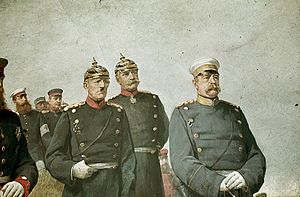
| Part of a series on |
| War (outline) |
|---|
 |
Militarism is the belief or the desire of a government or a people that a state should maintain a strong military capability and to use it aggressively to expand national interests and/or values.[1] It may also imply the glorification of the military and of the ideals of a professional military class and the "predominance of the armed forces in the administration or policy of the state"[2] (see also: stratocracy and military junta).
Militarism has been a significant element of the imperialist or expansionist ideologies of many nations throughout history. Notable ancient examples include the Assyrian Empire, the Greek city state of Sparta, the Roman Empire, the Aztec nation, and the Mongol Empire. Examples from modern times include the Ottoman Empire, the Kingdom of Prussia/German Empire/Third Reich, the British Empire, the Habsburg monarchy, the United States of America, the First French Empire, the Zulu Kingdom, the Empire of Japan, the Italian Empire under Benito Mussolini, Israel, North Korea, and the Russian Empire/Soviet Union/Russia.
By nation
[edit]Germany
[edit]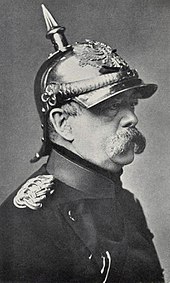
The roots of German militarism can be found in 18th- and 19th-century Prussia and the subsequent unification of Germany under Prussian leadership. However, Hans Rosenberg sees its origin already in the Teutonic Order and its colonization of Prussia during the late Middle Ages, when mercenaries from the Holy Roman Empire were granted lands by the Order and gradually formed a new landed militarist Prussian nobility, from which the Junker nobility would later evolve.[3]
During the 17th-century reign of the "Great Elector" Frederick William, Elector of Brandenburg, Brandenburg-Prussia increased its military to 40,000 men and began an effective military administration overseen by the General War Commissariat. In order to bolster his power both in interior and foreign matters, so-called Soldatenkönig ("soldier king") Frederick William I of Prussia started his large-scale military reforms in 1713, thus beginning the country's tradition of a high military budget by increasing the annual military spending to 73% of the entire annual budget of Prussia. By the time of his death in 1740, the Prussian Army had grown into a standing army of 83,000 men, one of the largest in Europe, at a time when the entire Prussian populace made up 2.5 million people. Prussian military writer Georg Henirich von Berenhorst would later write in hindsight that ever since the reign of the soldier king, Prussia always remained "not a country with an army, but an army with a country" (a quote often misattributed to Voltaire and Honoré Gabriel Riqueti, comte de Mirabeau).[4]
After Napoleon Bonaparte defeated Prussia in 1806, one of the conditions of peace was that Prussia should reduce its army to no more than 42,000 men. Since the time of Frederick The Great, however, Prussia practiced the Kruemper System, formed by dismissing a number of trained men at regular intervals and replacing them with raw recruits, thereby passing a large number of men through the ranks.[5] The officers of the army were drawn almost entirely from among the land-owning nobility. The result was that there was gradually built up a large class of professional officers on the one hand, and a much larger class, the rank and file of the army, on the other. These enlisted men had become conditioned to obey implicitly all the commands of the officers, creating a class-based culture of deference.[citation needed]

This system led to several consequences. Since the officer class also furnished most of the officials for the civil administration of the country, the interests of the army came to be considered as identical to the interests of the country as a whole. A second result was that the governing class desired to continue a system which gave them so much power over the common people, contributing to the continuing influence of the Junker noble classes.[citation needed]
Militarism in Germany continued after World War I and the fall of the German monarchy in the German Revolution of 1918–1919, in spite of Allied attempts to crush German militarism by means of the Treaty of Versailles, as the Allies saw Prussian and German militarism as one of the major causes of the Great War. During the period of the Weimar Republic (1918–1933), the 1920 Kapp Putsch, an attempted coup d'état against the republican government, was launched by disaffected members of the armed forces. After this event, some of the more radical militarists and nationalists were submerged in grief and despair into the NSDAP party of Adolf Hitler, while more moderate elements of militarism declined and remained affiliated with the German National People's Party (DNVP) instead.[citation needed]
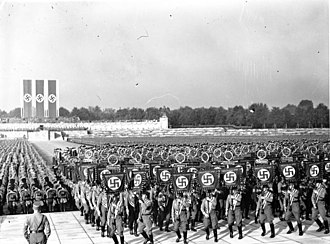
Throughout its entire 14-year existence, the Weimar Republic remained under threat of militaristic nationalism, as many Germans felt the Treaty of Versailles humiliated their militaristic culture. The Weimar years saw large-scale right-wing militarist and paramilitary mass organizations such as Der Stahlhelm as well as militias such as the Freikorps, which was banned in 1921.[6] In the same year, the Reichswehr set up the Black Reichswehr, a secret reserve of trained soldiers networked within its units organised as "labour battalions" (Arbeitskommandos) to circumvent the Treaty of Versailles' 100,000 man limit on the German army.;[7] it was dissolved in 1923. Many members of the Freikorps and the Black Reichswehr went on to join the Sturmabteilung (SA), the paramilitary branch of the Nazi party. All of these were responsible for the political violence of so-called Feme murders and an overall atmosphere of lingering civil war during the Weimar period. During the Weimar era, mathematician and political writer Emil Julius Gumbel published in-depth analyses of the militarist paramilitary violence characterizing German public life as well as the state's lenient to sympathetic reaction to it if the violence was committed by the political right.[citation needed]
Nazi Germany was a strongly militarist state; after its defeat in 1945, militarism in German culture was dramatically reduced as a backlash against the Nazi period, and the Allied Control Council and later the Allied High Commission oversaw a program of attempted fundamental re-education of the German people at large in order to put a stop to German militarism once and for all.[citation needed]
The Federal Republic of Germany today maintains a large, modern military and has one of the highest defence budgets in the world; at 1.3 percent of Germany's GDP, it is, in 2019, similar in cash terms to those of the United Kingdom, France and Japan, at around US$50bn.[8]
India
[edit]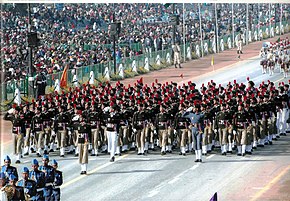
The rise of militarism in India dates back to the British Raj with the establishment of several Indian independence movement organizations such as the Indian National Army led by Subhas Chandra Bose. The Indian National Army (INA) played a crucial role in pressuring the British Raj after it occupied the Andaman and Nicobar Islands with the help of Imperial Japan, but the movement lost momentum due to lack of support by the Indian National Congress, the Battle of Imphal, and Bose's sudden death.
After India gained independence in 1947, tensions with neighbouring Pakistan over the Kashmir dispute and other issues led the Indian government to emphasize military preparedness (see also the political integration of India). After the Sino-Indian War in 1962, India dramatically expanded its military which helped India win the Indo-Pakistani War of 1971.[9] India became the third Asian country in the world to possess nuclear weapons, culminating in the tests of 1998. The Kashmiri insurgency and recent events including the Kargil War against Pakistan, assured that the Indian government remained committed to military expansion. The disputed Jammu and Kashmir region is regarded as one of the world’s most militarized places.[10]
In recent years, the Indian government has increased the military expenditure of the 1.4 million-strong military across all branches and embarked on a rapid modernization program.[11][12]
Japan
[edit]
In parallel with 20th-century German militarism, Japanese militarism began with a series of events by which the military gained prominence in dictating Japan's affairs. This was evident in 15th-century Japan's Sengoku period or Age of Warring States, where powerful samurai warlords (daimyōs) played a significant role in Japanese politics. Japan's militarism is deeply rooted in the ancient samurai tradition, centuries before Japan's modernization. Even though a militarist philosophy was intrinsic to the shogunates, a nationalist style of militarism developed after the Meiji Restoration, which restored the Emperor to power and began the Empire of Japan. It is exemplified by the 1882 Imperial Rescript to Soldiers and Sailors, which called for all members of the armed forces to have an absolute personal loyalty to the Emperor.
In the 20th century (approximately in the 1920s), two factors contributed both to the power of the military and chaos within its ranks. One was the "Military Ministers to be Active-Duty Officers Law", which required the Imperial Japanese Army (IJA) and Imperial Japanese Navy (IJN) to agree to the Ministry of Army position in the Cabinet. This essentially gave the military veto power over the formation of any Cabinet in the ostensibly parliamentary country. Another factor was gekokujō, or institutionalized disobedience by junior officers.[13] It was not uncommon for radical junior officers to press their goals, to the extent of assassinating their seniors. In 1936, this phenomenon resulted in the February 26 Incident, in which junior officers attempted a coup d'état and killed leading members of the Japanese government. The rebellion enraged Emperor Hirohito and he ordered its suppression, which was successfully carried out by loyal members of the military.

In the 1930s, the Great Depression damaged Japan's economy and gave radical elements within the Japanese military the chance to realize their ambitions of conquering all of Asia. In 1931, the Kwantung Army (a Japanese military force stationed in Manchuria) staged the Mukden Incident, which sparked the Invasion of Manchuria and its transformation into the Japanese puppet state of Manchukuo. Six years later, the Marco Polo Bridge Incident outside Peking sparked the Second Sino-Japanese War (1937–1945). Japanese troops streamed into China, conquering Peking, Shanghai, and the national capital of Nanking; the last conquest was followed by the Nanking Massacre. In 1940, Japan entered into an alliance with Nazi Germany and Fascist Italy, two similarly militaristic states in Europe, and advanced out of China and into Southeast Asia. The following year, Japan attacked Pearl Harbor to prevent the intervention of the United States, which had banned oil sales to Japan in response to the Second Sino-Japanese War and the ensuing invasion of Indochina.
In 1945, Japan surrendered to the United States, beginning the Occupation of Japan and the purging of all militarist influences from Japanese society and politics. In 1947, the new Constitution of Japan supplanted the Meiji Constitution as the fundamental law of the country, replacing the rule of the Emperor with parliamentary government. With this event, the Empire of Japan officially came to an end and the modern State of Japan was founded.
North Korea
[edit]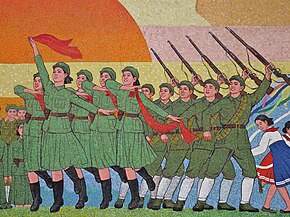
Sŏn'gun (often transliterated "songun"), North Korea's "Military First" policy, regards military power as the highest priority of the country. This has escalated so much in the DPRK that one in five people serves in the armed forces, and the military has become one of the largest in the world.
Songun elevates the Korean People's Armed Forces within North Korea as an organization and as a state function, granting it the primary position in the North Korean government and society. The principle guides domestic policy and international interactions.[14] It provides the framework of the government, designating the military as the "supreme repository of power". It also facilitates the militarization of non-military sectors by emphasizing the unity of the military and the people by spreading military culture among the masses.[15] The North Korean government grants the Korean People's Army as the highest priority in the economy and in resource-allocation, and positions it as the model for society to emulate.[16] Songun is also the ideological concept behind a shift in policies (since the death of Kim Il Sung in 1994) which emphasize the people's military over all other aspects of state and the interests of the military comes first before the masses (workers).
Philippines
[edit]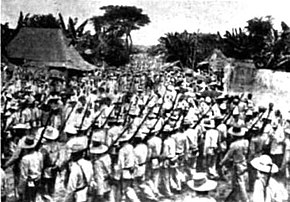
In the pre-colonial era, the Filipino people had their own forces, divided between the islands which each had its own ruler. They were called Sandig (Guards), Kawal (Knights), and Tanod. They also served as the police and watchers on the land, coastlines and seas. In 1521, the Visayan king of Mactan Lapu-Lapu of Cebu, organized the first recorded military action against the Spanish colonizers, in the Battle of Mactan.
In the 19th century during the Philippine Revolution, Andrés Bonifacio founded the Katipunan, a revolutionary organization against Spain at the Cry of Pugad Lawin. Some notable battles were the Siege of Baler, the Battle of Imus, Battle of Kawit, Battle of Nueva Ecija, the victorious Battle of Alapan and the famous Twin Battles of Binakayan and Dalahican. During Independence, the President General Emilio Aguinaldo established the Magdalo, a faction separate from Katipunan, and he declared the revolutionary government in the constitution of the First Philippine Republic.
During the Filipino-American War, the General Antonio Luna as a high-ranking general, he ordered a conscription to all citizens, a mandatory form of national service (at any war) for the increase the density and the manpower of the Philippine Army.
During the World War II, the Philippines was one of the participants, as a member of Allied forces, the Philippines with the U.S. forces fought the Imperial Japanese Army (1942–1945), one of the notable battles is the victorious Battle of Manila, which also called "The Liberation".
During the 1970s the President Ferdinand Marcos declared P.D.1081 or martial law, which also made the Philippines a garrison state. By the Philippine Constabulary (PC) and Integrated National Police (INP), the high school or secondary and college education have a compulsory curriculum concerning the military, and nationalism which is the "Citizens Military Training" (CMT) and "Reserve Officers Training Corps" (ROTC). But in 1986, when the constitution changed, this form of national service training program became non-compulsory but still part of the basic education.[17]
Russia
[edit]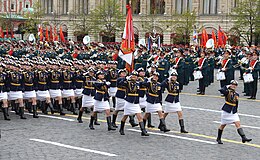
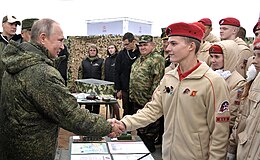
Russia has also had a long history of militarism continuing on to the present day driven by its desire to protect its western frontier which has no natural buffers between potential invaders from the rest of continental Europe and her heartlands in European Russia. Ever since Peter the Great's reforms, Russia became one of Europe's great powers in terms of political and military strength. Through the Imperial era, Russia continued on her quest for territorial expansion into Siberia, Caucasus and into Eastern Europe, eventually conquering the majority of the Polish-Lithuanian Commonwealth.
The end of imperial rule in 1917 meant the loss of some territory following the treaty of Brest-Litovsk, but much of it was quickly reconquered by the Soviet Union later on, including events such as the partition of Poland and reconquest of the Baltic states in the late 1930s and ‘40s. Soviet influence reached its peak after WWII in the Cold War era, during which the Soviet Union occupied virtually all of Eastern Europe in a military alliance known as the Warsaw Pact, with the Soviet Army playing a key role. All this was lost with the dissolution of the Soviet Union in 1991. Russia was greatly weakened in what Russia's second President Vladimir Putin called the greatest geopolitical disaster of the 20th century. Nevertheless, under Putin's leadership, a resurgent modern Russia has maintained a tremendous amount of geopolitical influence in the countries spawned from the dissolution of the Soviet Union, and modern Russia remains Eastern Europe's leading, if not dominant, power.
Following the Russian invasion of Ukraine, the Russian government increased their efforts to introduce "patriotic education" into schools.[18] The Associated Press reported that some parents were shocked by the militaristic nature of the Kremlin-promoted Important Conversations lessons, with some comparing them to the "patriotic education" of the former Soviet Union.[19]
By the end of 2023, Vladimir Putin planned to spend almost 40% of public expenditures on defense and security.[20] UK Chief of Defence Staff Admiral Tony Radakin said that "the last time we saw these levels was at the end of the Cold War and the collapse of the Soviet Union."[21]
Turkey
[edit]Militarism has a long history in Turkey.
The Ottoman Empire lasted for centuries and always relied on its military might, but militarism was not a part of everyday life. Militarism was only introduced into daily life with the advent of modern institutions, particularly schools, which became part of the state apparatus when the Ottoman Empire was succeeded by a new nation state – the Republic of Turkey – in 1923. The founders of the republic were determined to break with the past and modernise the country. There was, however, an inherent contradiction in that their modernist vision was limited by their military roots. The leading reformers were all military men and, in keeping with the military tradition, all believed in the authority and the sacredness of the state. The public also believed in the military. It was the military, after all, who led the nation through the War of Liberation (1919–1923) and saved the motherland.
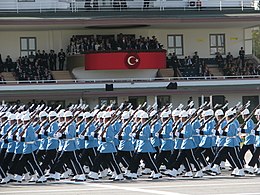
The first military coup in the history of the republic was on 27 May 1960, which resulted in the hanging of PM Adnan Menderes and 2 ministers, and a new constitution was introduced, creating a Constitutional Court to vet the legislation passed by parliament, and a military-dominated National Security Council to oversee the government affairs similar to the politburo in the Soviet Union.[22] The second military coup took place on 12 March 1971, this time only forcing the government to resign and installing a cabinet of technocrats and bureaucrats without dissolving the parliament. The third military coup took place on 12 September 1980, which resulted in the dissolution of parliament and all political parties as well as imposition of a much more authoritarian constitution. There was another military intervention that was called a "post-modern coup" on 28 February 1997 which merely forced the government to resign, and finally an unsuccessful military coup attempt on 15 July 2016.
The constitutional referendums in 2010 and 2017 have changed the composition and role of the National Security Council, and placed the armed forces under the control of civilian government.
United States
[edit]In the late nineteenth and early twentieth centuries political and military leaders reformed the US federal government to establish a stronger central government than had ever previously existed for the purpose of enabling the nation to pursue an imperial policy in the Pacific and in the Caribbean and economic militarism to support the development of the new industrial economy. This reform was the result of a conflict between Neo-Hamiltonian Republicans and Jeffersonian-Jacksonian Democrats over the proper administration of the state and direction of its foreign policy. The conflict pitted proponents of professionalism, based on business management principles, against those favoring more local control in the hands of laymen and political appointees. The outcome of this struggle, including a more professional federal civil service and a strengthened presidency and executive branch, made a more expansionist foreign policy possible.[23]
After the end of the American Civil War the national army fell into disrepair. Reforms based on various European states including Britain, Germany, and Switzerland were made so that it would become responsive to control from the central government, prepared for future conflicts, and develop refined command and support structures; these reforms led to the development of professional military thinkers and cadre.

During this time the ideas of social Darwinism helped propel American overseas expansion in the Pacific and Caribbean.[24][25] This required modifications for a more efficient central government due to the added administration requirements (see above).
The enlargement of the U.S. Army for the Spanish–American War was considered essential to the occupation and control of the new territories acquired from Spain in its defeat (Guam, the Philippines, Puerto Rico, and Cuba). The previous limit by legislation of 24,000 men was expanded to 60,000 regulars in the new army bill on 2 February 1901, with allowance at that time for expansion to 80,000 regulars by presidential discretion at times of national emergency.
U.S. forces were again enlarged immensely for World War I. Officers such as George S. Patton were permanent captains at the start of the war and received temporary promotions to colonel.
Between the first and second world wars, the US Marine Corps engaged in questionable activities in the Banana Wars in Latin America. Retired Major General Smedley Butler, who was at the time of his death the most decorated Marine, spoke strongly against what he considered to be trends toward fascism and militarism. Butler briefed Congress on what he described as a Business Plot for a military coup, for which he had been suggested as leader; the matter was partially corroborated, but the real threat has been disputed. The Latin American expeditions ended with Franklin D. Roosevelt's Good Neighbor policy of 1934.
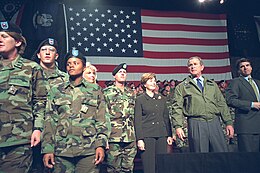
After World War II, there were major cutbacks, such that units responding early in the Korean War under United Nations authority (e.g. Task Force Smith) were unprepared, resulting in catastrophic performance. When Harry S. Truman fired Douglas MacArthur, the tradition of civilian control held and MacArthur left without any hint of military coup.
The Cold War resulted in serious permanent military buildups. Dwight D. Eisenhower, a retired top military commander elected as a civilian president, warned, as he was leaving office, of the development of a military–industrial complex.[26] In the Cold War, there emerged many civilian academics and industrial researchers, such as Henry Kissinger and Herman Kahn, who had significant input into the use of military force. The complexities of nuclear strategy and the debates surrounding them helped produce a new group of 'defense intellectuals' and think tanks, such as the Rand Corporation (where Kahn, among others, worked).[27]
It has been argued that the United States has shifted to a state of neomilitarism since the end of the Vietnam War. This form of militarism is distinguished by the reliance on a relatively small number of volunteer fighters; heavy reliance on complex technologies; and the rationalization and expansion of government advertising and recruitment programs designed to promote military service.[28] President Joe Biden signed a record $886 billion defense spending bill into law on December 22, 2023.[29][30]
Venezuela
[edit]
Militarism in Venezuela follows the cult and myth of Simón Bolívar, known as the liberator of Venezuela.[31] For much of the 1800s, Venezuela was ruled by powerful, militarist leaders known as caudillos.[32] Between 1892 and 1900 alone, six rebellions occurred and 437 military actions were taken to obtain control of Venezuela.[32] With the military controlling Venezuela for much of its history, the country practiced a "military ethos", with civilians today still believing that military intervention in the government is positive, especially during times of crisis, with many Venezuelans believing that the military opens democratic opportunities instead of blocking them.[32]
Much of the modern political movement behind the Fifth Republic of Venezuela, ruled by the Bolivarian government established by Hugo Chávez, was built on the following of Bolívar and such militaristic ideals.[31]
See also
[edit]References
[edit]Notes
- ^ New Oxford American Dictionary (2007)
- ^ "Militarism". The Free Dictionary.
- ^ Rosenberg, H. (1943). The Rise of the Junkers in Brandenburg-Prussia, 1410-1653: Part 1. The American Historical Review, 49(1), 1-22
- ^ Aus dem Nachlasse von Georg Heinrich von Berenhorst. Herausgegeben von Eduard von Bülow. Erste Abteilung 1845. Verlag von Aue in Dessau.S. 187 books.google. Rezension in Literaturblatt (Beilage zum Morgenblatt für gebildete Stände) No. 48 vom 7. Juli 1846, S. 191 rechts oben books.google
- ^ Hofschröer, Peter (2012). Prussian Reserve, Militia & Irregular Troops 1806–15. Publishing. p. 5. ISBN 9781780965185. Retrieved 10 October 2024.
- ^ Wilson, Tim (2010). Frontiers of Violence. Conflict and Identity in Ulster and Upper Silesia 1918-1922. Oxford: Oxford University Press. p. 83. ISBN 978-0199583713.
- ^ Wheeler-Bennett, John W. (1953). The Nemesis of Power (2nd ed.). London: Palgrave Macmillan. p. 92. ISBN 978-1-4039-1812-3.
- ^ Tian, Nan; Kuimova, Alexandra; Lopes da Silva, Diego; Wezeman, Pieter D.; Wezeman, Siemon T. (April 2020). "Trends in World Military Expenditure, 2019" (PDF). Stockholm International Peace Research Institute. Retrieved 20 November 2020.
- ^ Srinath Raghavan, 1971: A Global History of the Creation of Bangladesh (Harvard Univ. Press, 2013).
- ^ Nanda, Showkat; Loke, Atul (8 March 2023). "India Is Arming Villagers in One of Earth's Most Militarized Places". The New York Times.
- ^ "How India is ramping up military modernization efforts". Deutsche Welle. 5 January 2022.
- ^ "India's Military Modernization in Doubt With Tiny Budget Rise". Bloomberg. 1 February 2023.
- ^ "Strengths and Weaknesses in the Decision-Making Process" Craig AM in Vogel, EM (ed.), Modern Japanese Organization and Decision-Making, University of California Press, 1987.
- ^ Vorontsov, Alexander V (26 May 2006). "North Korea's Military-First Policy: A Curse or a Blessing?". Brookings Institution. Archived from the original on 31 May 2006. Retrieved 26 March 2007.
- ^ New Challenges of North Korean Foreign Policy By K. Park
- ^ Jae Kyu Park, "North Korea since 2000 and prospects for Inter Korean Relations" Korea.net, 19 January 2006, <http://www.korea.net/News/Issues/IssueDetailView.asp?board_no=11037 Archived 13 November 2007 at the Wayback Machine> 12 May 2007.
- ^ Militarism in the Philippines. 2005.
- ^ Ilyushina, Mary (20 March 2022). "Putin's war propaganda becomes 'patriotic' lessons in Russian schools". The Washington Post. Washington, D.C.: Fred Ryan. Archived from the original on 27 March 2022.
- ^ Litvinova, Dasha (1 September 2023). "Russian students are returning to school, where they face new lessons to boost their patriotism". AP News. New York City: Associated Press. Archived from the original on 2 September 2023.
- ^ "Putin approves big military spending hikes for Russia's budget". Reuters. 27 November 2023.
- ^ "Nearly 40% of Russian public spending on defence – UK defence chief". Army Technology. 15 December 2023.
- ^ Columnist M. Ali Kışlalı cites Army commander Faruk Gürler for this comparison in his article "MGK değişti ama" in the newspaper "Radikal", dated 4 July 2007. https://www.ab.gov.tr/p.php?e=36535
- ^ Fareed Zakaria, From Wealth to Power: The Unusual Origins of America's World Role (Princeton Univ. Press, 1998), chap.4.
- ^ Richard Hofstadter (1992). Social Darwinism in American Thought. Beacon Press. ISBN 978-0-8070-5503-8.
- ^ Spencer Tucker (2009). The Encyclopedia of the Spanish-American and Philippine-American Wars: A Political, Social, and Military History. ABC-CLIO. ISBN 978-1-85109-951-1.
- ^ Audra J. Wolfe, Competing with the Soviets: Science, Technology, and the State in Cold War America (Johns Hopkins Univ. Press, 2013), chap.2.
- ^ Fred Kaplan, The Wizards of Armageddon (1983, reissued 1991).
- ^ Roberts, Alasdair. The Collapse of Fortress Bush: The Crisis of Authority in American Government Archived 2 March 2008 at the Wayback Machine. New York: New York University Press, 2008, 14 and 108–117.
- ^ "Biden signs record $886 billion defense bill into law". Axios. 23 December 2023.
- ^ "Biden signs defense policy bill, extending controversial spying program". Politico. 22 December 2023.
- ^ a b Uzcategui, Rafael (2012). Venezuela: Revolution as Spectacle. See Sharp Press. pp. 142–149. ISBN 9781937276164.
- ^ a b c Block, Elena (2015). Political Communication and Leadership: Mimetisation, Hugo Chavez and the Construction of Power and Identity. Routledge. pp. 74–91. ISBN 9781317439578.
Further reading
- Bacevich, Andrew J. The New American Militarism. Oxford: University Press, 2005.
- Barr, Ronald J. "The Progressive Army: US Army Command and Administration 1870–1914." St. Martin's Press, Inc. 1998. ISBN 0-312-21467-7.
- Barzilai, Gad. Wars, Internal Conflicts and Political Order. Albany: State University of New York Press. 1996.
- Bond, Brian. War and Society in Europe, 1870–1970. McGill-Queen's University Press. 1985 ISBN 0-7735-1763-4
- Conversi, Daniele 2007 'Homogenisation, nationalism and war’, Nations and Nationalism, Vol. 13, no 3, 2007, pp. 1–24
- Ensign, Tod. America's Military Today. The New Press. 2005. ISBN 1-56584-883-7.
- Fink, Christina. Living Silence: Burma Under Military Rule. White Lotus Press. 2001. ISBN 1-85649-925-1.
- Freedman, Lawrence, Command: The Politics of Military Operations from Korea to Ukraine, Allen Lane, September 2022, 574 pp., ISBN 978 0 241 45699 6
- Frevert, Ute. A Nation in Barracks: Modern Germany, Military Conscription and Civil Society. Berg, 2004. ISBN 1-85973-886-9
- Huntington, Samuel P.. Soldier and the State: The Theory and Politics of Civil-Military Relations. Cambridge: Belknap Press of Harvard University Press, 1981.
- Ito, Tomohide: Militarismus des Zivilen in Japan 1937–1940: Diskurse und ihre Auswirkungen auf politische Entscheidungsprozesse (Reihe zur Geschichte Asiens; Bd. 19). Iudicium Verlag, München 2019. ISBN 978-3862052202
- Ritter, Gerhard. The Sword and the Scepter; the Problem of Militarism in Germany, translated from the German by Heinz Norden, Coral Gables, Fla., University of Miami Press 1969–73.
- Vagts, Alfred. A History of Militarism. Meridian Books, 1959.
- Western, Jon. Selling Intervention and War. Johns Hopkins University . 2005. ISBN 0-8018-8108-0
